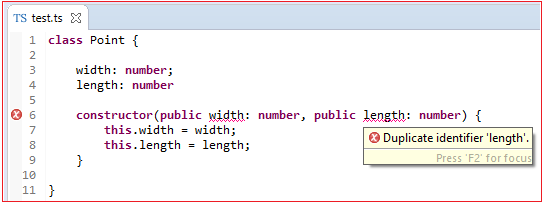


However, there is no way to ensure a value for new.target when invoking a constructor in ECMAScript 5. This is due to the fact that constructor functions for Error, Array, and the like use ECMAScript 6’s new.target to adjust the prototype chain nstructor should be the class definition, and nstructor the immediate super prototype definition, and so on.
#TYPESCRIPT CLASS CONSTRUCTOR CODE#
It is necessary for generated constructor code to capture any potential return value of super(.) and replace it with this.Īs a result, subclassing Error, Array, and others may no longer work as expected. Well, since the constructor, per spec (and after typescript compilation) is always the defined in the prototype, I dont see why it shouldnt be strongly typed.If people are hacking their prototypes manually, let them typecast their code. If a class has no constructor, a constructor is provided automatically. A class may contain at least one constructor declaration. A Constructor is a special type of method of a class and it will be automatically invoked when an instance of the class is created. In ES2015, constructors which return an object implicitly substitute the value of this for any callers of super(.). Constructors are identified with the keyword 'constructor'. constructor property of instances point to the exposed wrapper (which may be an advantage or disadvantage depending on the circumstances) The simplified versions dont provide all meta-data for introspection if you dont need it. or your compilation target is explicitly set to ES6/ ES2015 or above, you may skip this section

Note: If you don’t plan to inherit from built-in types like Array, Error, Map, etc. The this keyword refers to the current instance of the class. A constructor is a function and hence can be parameterized.

To achieve this, create a new type at the index of Keys. Type contains: 'a' 'b' type Keys keyof typeof map Next I need all associated values for each key. Therefore I'll create a new type called: Keys. TypeScript defines a constructor using the constructor keyword. First I want to extract all keys of the map object. This means that the base class constructor saw its own value for name during its own constructor, because the derived class field initializations hadn’t run yet. A constructor is a special function of the class that is responsible for initializing the variables of the class. The derived class fields are initialized.But in TypeScript, unlike any other object-oriented language, only one constructor is allowed. It prepares a new object, for which often accepting arguments is used to set the required variables of the class. This is why I prefer sticking to multiple, comma-separated parameters.The order of class initialization, as defined by JavaScript, is: In this example we use the constructor to declare a public property position and a protected property speed in the base class. To put it in simple terms, a constructor is a function which is called to create an object of the class, in which it is defined. Wrapping it up We've seen that TypeScript ensures correct usage of constructors when we have an abstract class. TypeScript enforces that we pass the appropriate arguments (in our case a single string). When you have an object parameter in a class constructor, things become a bit This invokes the constructor of the ViewModel base (or 'super') class. Winter : boolean } constructor ( console.


 0 kommentar(er)
0 kommentar(er)
